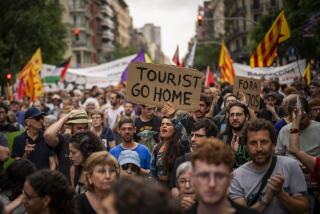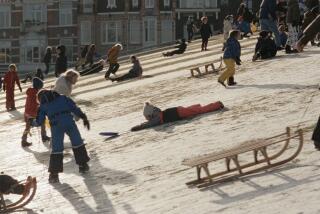Holland, by Bike and Barge
AMSTERDAM -- On a bike tour through southern Holland in June, my group stopped at Madurodam, a popular theme park that replicates the country in miniature. There is a little Rijksmuseum, Amsterdamâs repository of Dutch masters; the town hall of Gouda, the cheese center; and Schiphol Airport. In the theme park, Amsterdam lies about 25 feet from Rotterdam. In reality, 45 miles separate them--too far to walk but not too far to cycle in a day.
Thatâs the way it is in the Netherlands, a country in miniature that, at 16,033 square miles, is just four times larger than L.A. County, give or take. Even at life size, nothing is far away, making it the perfect place for a biking vacation. Thatâs especially true for cyclists like me, who want to see the sights but arenât training for the Tour de France.
There were other reasons to choose a bike tour in Holland. Above all, itâs flat. These are Europeâs lowlands, with farmland (called polder land) reclaimed from marshes and the sea. Bike paths abound, taking cyclists past windmills and canals surrounded by bucolic landscapes; those who travel by car along motor ways see much more urban sprawl. Everyone bikes here, and cyclistsâ rights are respected. When an accident occurs between a bicycle and an automobile, by Dutch law the motorist is always at fault.
I also found what turned out to be an excellent bike tour at a surprisingly low price, offered by a 19-year-old Dutch company called Cycletours International. Cycletours organizes group and independent biking vacations all over Europe, with luggage transfers and lodgings booked along the way. I was most attracted to its four- and seven-night trips--most of which begin in Amsterdam--on which travelers overnight on river barges. By day, groups of 15 to 30 participants, led by guides, head out on bikes as the barge floats to its evening destination. After the cyclists rendezvous with the boat, thereâs dinner on board, exploring the town, and the same bunk to tuck into, which, in a way, is nicer than staying in a different place every night.
Cycletours isnât into luxury, though. Thereâs little hand-holding during the rides, which seldom cover more than 35 miles a day. The food is sustaining but a far cry from gourmet: breakfasts of granola, cheese, cold cuts and bread--out of which we made our packed lunches--and dinners of steamed salmon and mushy pasta, or not-very-Chinese cashew chicken. Nor were accommodations on the barges fancy. I had a small, plain cabin to myself, with two bunks covered by duvets, a sink, tiny closet, stool, porthole and private shower/toilet cabinet.
But you canât beat the price. For a four-night trip on the 86-mile southern route, with overnight stops in Utrecht, Schoonhoven, Delft and Leiden, I paid $500, including meals, accommodations, a single supplement, the services of a tour guide and a bike--but not, of course, including air fare. I booked the trip through Van Gogh Tours, a Massachusetts travel agency, but later discovered that prices are slightly cheaper if you make your arrangements directly with Cycletours in the Netherlands.
If you fly nonstop from L.A. to Amsterdam, as I did, itâs best to see the city and get over jet lag before starting a cycling trip. I got in on a Friday afternoon and wasnât really ready for biking when the tour started the next day. Besides, as anyone whoâs been to Amsterdam knows, the city deserves much more than a day.
I did get a chance to buy my niece six wooden buttons painted to resemble ladybugs at a charming little button shop near the center of town and to visit the Anne Frank House on Prinsengracht canal. There I learned that one of the first things the Germans did when they took over Amsterdam in World War II was to ban Jews from riding bikes.
I stayed at the intimate, refined Ambassade Hotel, overlooking another lovely, leafy canal, and dined on steamed trout and French fries at a pretty bistro called Proeverij (pronounced PRO-verray) nearby, with a huge bouquet of red and white roses on the bar.
But what impressed me most is that the city, with a population of 727,000, has about 400,000 bikes. Everyone from wedding guests to the mayor rides them, and all the train stations have bike rental and parking facilities. One fancies that the Dutch learn to bike right after they take their first steps. And as cyclists, they are extremely adept, able to ride while doing other things, like use cell phones, argue politics and kiss (as I saw two young lovers do on a canal bridge).
At a little bike shop near my hotel, for about $15 I bought a padded seat cover and biking gloves from a helpful clerk. I had been advised in advance to pack my biking helmet. In Holland, using helmets isnât mandatory, and most of the people in my group--17 of us, from Europe and North America--didnât wear them.
On a rainy Saturday afternoon I boarded the barge, docked in a boat basin just southeast of the train station. Named Felicitas, it is a flat, unlovely but trusty-looking vessel that worked the canals before being refitted for bike tours. The foredeck had benches, a big potted plant, a few chaises and wicker chairs, a patio umbrella and about 30 Dutch-made hybrid 21-speed bikes parked in tight formation. The dining room, with institutional tables and chairs (and a few board games no one played), was in the middle and the galley was at the back, with 13 cabins below. Lounging space was limited, partly because of the small size of the boat and partly because of the big presence of a shaggy, perpetually rain- and river-water-soaked dog called Sarah, owned by the capable young female captain, Sanne van Sonsbeeck.
Once all our group had arrived, our tour guide, Jelle Oud, presided over a brief orientation meeting in the dining room, with store-bought cookies and coffee and tea. He told us--in English, German and French--about the self-serve wine-and-beer honor bar (not included in the tour price) and explained the dayâs itinerary.
The barge would take us south, down the wide, busy Amsterdam Rhine River Canal to the village of Nigtevecht. From there weâd ride our bikes about 10 miles along the graceful Vechte River to Breukelen--for which Brooklyn, N.Y., was named--where the Felicitas would be waiting for us. Then, while the barge took us on to the historic cathedral city of Utrecht, weâd have dinner.
Truthfully, little orientation was needed. The whole trip was about getting on bikes when Jelle (pronounced Yella) told us to, and following his lead.
Fortunately he was a good man to follow--a retired KLM airline pilot--though he smoked cigarettes while cycling and had only recently started leading trips for Cycletours. I reckoned his age to be about 60; he said he did speed-skating in winter, and he had the physique for it. Clearly, he could have out-pedaled any of us. As the trip evolved, every woman in the group grew sweet on him.
Sometimes he got lost, and when I asked him why William the Silent, the 16th century prince who was instrumental in liberating the Netherlands from Spain, was called âthe silent,â he couldnât say. Regardless, there was something about him that inspired confidence. One day, when we looked back and saw that half the group was missing, he quickly realized theyâd made a wrong turn, zipped back on his bike and rounded them up. And he was a real jack-of-all-trades with languages, turning the Americans, French Canadians, Norwegians (who spoke English) and Germans into one big happy, babbling family.
Weâd been asked for our heights on registration materials, so the bikes were the right size, with seats pre-adjusted, panniers over the rear wheels and tags bearing our names. Jelle told us we could leave the main, front gear in second because there are virtually no hills in Holland. (We did use the rear gears, though, which shifted in smaller increments.)
One of the few potential drawbacks to biking in the Netherlands is the weather. But that first wet day we bundled up in rain jackets and soon found ourselves pedaling leisurely past neat houseboats, with yards, garages and some of the biggest hydrangeas Iâve ever seen.
Near the village of Loenen we saw our first thatch-roofed windmill and crossed over a one-lane drawbridge. (The attendant told us he worked from 9 a.m. to 9 p.m. in summer but had to be summoned by telephone when someone wanted to go over the bridge in winter.)
Between the villages, we traveled through polder land mowed by goats, sheep and cows, which left me craving a cold glass of chocolate milk. Every farmhouse we passed looked like something out of a painting by Pieter de Hooch or Jan Vermeer, with windows kept so scrupulously clean that they gleamed like diamonds, revealing glimpses of thriving potted plants, lace antimacassars and china caddies inside. Chicagoan Stephanie Weidner, whoâd come on the trip with her husband, Conrad Lawrence, was struck by the sense of decorum in the Dutch landscape. âItâs all so cute,â she kept saying.
That afternoon we didnât stop to tour any sights, though we would later. But it didnât matter, because touring by bike is a special way of traveling, less about sightseeing than about taking in the scenery by just letting it flow past. Those who wish to study architecture and visit museums would be better served by a car or bus tour.
On the second day, we did stop. In the village of Haarzuilens, a couple from Toronto gave me their camera to snap them in front of the burnished gates of De Haar Castle. Stephanie, Conrad and I toured the Witch Museum in Oudewater, where thereâs an antique scale for weighing witches, who were thought to be light in order to ride broomsticks. Later the whole group heard a lecture on Dutch hydraulic engineering at the Canal Museum in Haastrecht. Then we pedaled on to pretty Schoonhoven, a walled town on the Lek River noted for its silversmiths.
From there, our third day of biking took us along the south side of the Lek. Along the way we toured a stork preserve, rode through more green polder lands and saw a string of 17 picture-perfect windmills near the village of Kinderdijk, where the Felicitas picked us up to take us through modern, industrial Rotterdam Harbor to Delft.
There we got an instructive tour of the Royal Delft porcelain factory and rode on to The Hague, the Atlantic Ocean beach resort of Scheveningen, the dunes near Kat- wijk (where we actually had to push up a few hills) and the university town of Leiden, birthplace of Rembrandt and departure point (in 1620) of the Pilgrims.
It was in Leiden that I collected one of my fondest memories of the trip. At a pretty bar in one of the townâs restored gatehouses, I settled into a seat with Louise Gareau, a French Canadian tour member. As we sipped drinks, we shared the stories of our lives and giggled like schoolgirls about the men in them.
Alas, Conrad, Stephanie and I were scheduled to leave the group the next morning in Leiden. Everybody else was on the seven-night tour, headed the next day to Haarlem. I imagined Jelle and the group would miss us as they pedaled on. I knew I would miss them.
Holland is a small, cozy place, where I got the feeling people care about one another--though I doubt Iâd have felt that if I hadnât been on a bike tour.
More to Read
Sign up for The Wild
Weâll help you find the best places to hike, bike and run, as well as the perfect silent spots for meditation and yoga.
You may occasionally receive promotional content from the Los Angeles Times.






